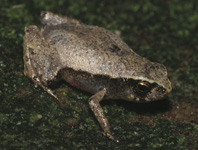Abstract
The final instar larva of Orthetrum borneense Kimmins, 1936, is described and figured for the first time based on exuviae from three male and six female larvae collected in Sarawak, Borneo (East Malaysia). It is compared with an early instar larva, which was matched to the adult O. borneense by DNA barcoding, and the known larvae of other species of this genus that occur in the region.
References
Dijkstra, K-D. B., Kalkman, V.J., Dow, R.A., Stokvis, F.R. & van Tol., J. (2014) Redefining the damselfly families: a comprehensive molecular phylogeny of Zygoptera (Odonata). Systematic Entomology, 39 (1), 68–96.
http://dx.doi.org/10.1111/syen.12035Dow, R.A. & Ngiam, R.W.J. (2012) Odonata collected in the Hose Mountains, Kapit Division, Sarawak, Malaysia in April 2011. International Dragonfly Fund Report, 44, 1–18.
Dow, R.A., Reels, G.T. & Butler, S.G. (2013) Odonata of the Dulit Range in Sarawak, Malaysian Borneo. Notulae odonatologicae, 8 (1), 1–16.
Dow, R.A., Reels, G.T. & Ngiam, R.W.J. (2015) Previously unpublished Odonata records from Sarawak, Borneo, Part III. Sri Aman, Sibu and Kapit Divisions. Faunistic Studies in South-East Asian and Pacific Island Odonata, 9, 1–34.
Folmer, O., Black, M., Hoeh, W., Lutz, R. & Vrijenhoek, R. (1994) DNA primers for amplification of mitochondrial cytochrome coxidase subunit I from diverse metazoan invertebrates. Molecular Marine Biology and Biotechnology, 3 (5), 294–299.
Hall, T.A. (1999) BioEdit: a user-friendly biological sequence alignment editor and analysis program for Windows 95/98/NT. Nucleic Acids Symposium Series, 41, 95–98.
Hebert, P.D.N., Penton, E.H., Burns, J.M., Janzen, D.H. & Hallwachs, W. (2004) Ten species in one: DNA barcoding reveals cryptic species in the neotropical skipper butterfly Astraptes fulgerator. Proceedings of the National Academy of Sciences of the United States of America, 101 (41), 14812–14817.
http://dx.doi.org/10.1073/pnas.0406166101Ishida, K. (1996) Monograph of Odonata larvae in Japan. Hokkaido University Press, Sapporo. [in Japanese].
Kearse, M., Moir, R., Wilson, A., Stones-Havas, S., Cheung, M., Sturrock, S., Buxton, S., Cooper, A., Markowitz, S., Duran, C., Thierer, T., Ashton, B., Mentjies, P., & Drummond, A. (2012) Geneious Basic: an integrated and extendable desktop software platform for the organization and analysis of sequence data. Bioinformatics, 28 (12), 1647–1649.
http://dx.doi.org/10.1093/bioinformatics/bts199Kimmins, D.E. (1936) The Odonata of the Oxford University Sarawak Expedition. Journal of the Federated Malay States Museum, 18, 65–108.
Orr A.G. (2003) A Guide to the Dragonflies of Borneo: Their identification and biology. Natural History Publications, Kota Kinabalu, 195 pp.
Orr, A.G. & Dow, R.A. (2015) Description of two final stadium platystictid larvae from Borneo, including the larva of Drepanosticta ?attala Lieftinck, identified using DNA barcoding (Odonata: Zygoptera: Platystictidae). Zootaxa, 3985 (4), 565–574.
http://dx.doi.org/10.11646/zootaxa.3985.4.5Rach, J., DeSalle, R., Sarkar, I.N., Schierwater, B. & Hadrys, H. (2008) Character-based DNA barcoding allows discrimination of genera, species and populations in Odonata. Proceedings of the Royal Society B, 275, 237–247.
http://dx.doi.org/10.1098/rspb.2007.1290Ratnasingham, S. & Hebert, P.D.N. (2007) BOLD: the barcode of life data system (www.barcodinglife.org). Molecular Ecology Notes, 7, 355–364.
http://dx.doi.org/10.1111/j.1471-8286.2007.01678.xSchorr, M. & Paulson, D. (2015) World Odonata List. University of Puget Sound, WA. Available from http://www.pugetsound.edu/academics/academic-resources/slater-museum/biodiversity-resources/dragonflies/world-odonata-list/ (assessed 22 March 2015)
Steinhoff, P.O.M. (2015) Results of Odonata larval rearing in the Gunung Mulu National Park, Sarawak, Malaysia from April to August 2014. International Dragonfly Fund Report, 78, 1–11.
Yong, H.S., Lim, P.-E., Tan, J., Ng, Y.F., Eamsobhana, P. & Suana, I.W. (2014) Molecular phylogeny of Orthetrum dragonflies reveals cryptic species of Orthetrum pruinosum. Scientific Reports, 4, 5553.
http://dx.doi.org/10.1038/srep05553

